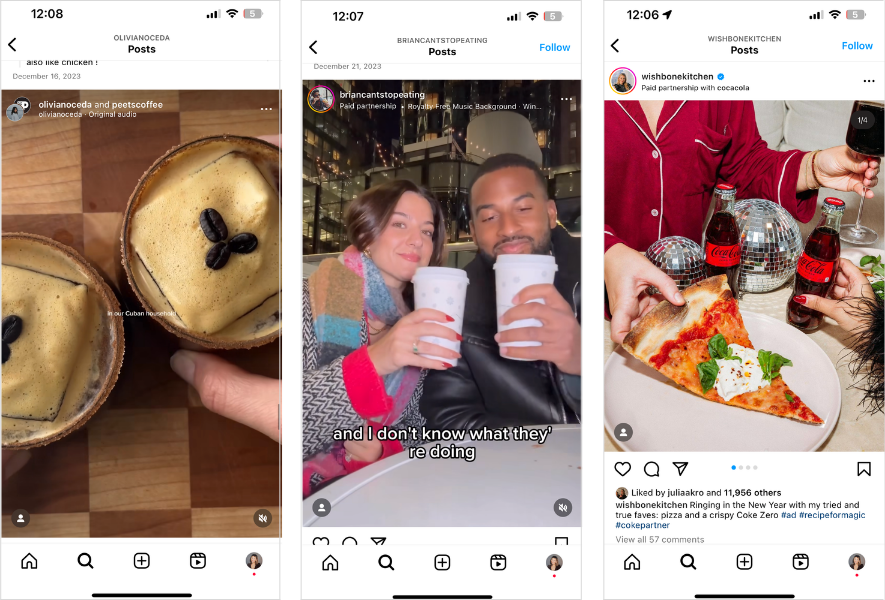If you want to grow your food and beverage brand in 2024, tapping into influencer marketing is a great place to start.
With the right food creators, you can target potential customers, build your brand awareness, and ultimately — reach your goals.
In this ultimate guide, we’ll walk you through everything you need to know about using influencer marketing for your food and beverage brand — from top influencers to successful campaigns.
Table of Contents
What Is Food Influencer Marketing?
Food influencer marketing is when businesses in the food and beverage industry partner with influencers who specialize in creating food-related content.
This content is then used to drive awareness, traffic, or sales of the business' product.

And with over 660M views of the #foodcontent hashtag on TikTok alone, the space is growing in popularity too, making it a good time for brands to tap in.
Why? Well, as the saying goes: “We eat first with our eyes.”
FYI: Later Influence™ is trusted by marketers and enterprise brands to source, manage, and analyze influencer marketing campaigns. Learn more.
What Type of Businesses Should Work With Food Influencers?
Food influencer marketing can be successful for a wide variety of food and beverage related brands such as:
Food delivery apps and services
Restaurants or bakeries
Coffee shops
Cocktail bars and pubs
Cookware and appliances
Grocery stores
Alcohol and alcohol-alternative brands
Beverage brands
Frozen food brands
Food markets
Consumer packaged goods
Tourism boards
The takeaway? If you have a food-specific (or even food-adjacent) business, you can tap into the power of influencer marketing.
Who Are Food and Beverage Influencers on Instagram and TikTok?
There are plenty of food and beverage influencers on social media.
There’s foodies who try local eats, those who create and share recipes, and others who simply eat on camera.
Each influencer niche has benefits to working with them, it all depends on your overall marketing goals (and budget).
We're breaking down the various types of food and beverage influencers — broken down into follower size.
#1: Food and Beverage Nano Influencers
What Is a Nano Influencer?
A Nano influencer is someone who has 0-10K followers on Instagram or TikTok.
The Benefit of Working With Nano Influencers
More cost-effective than Mid or Macro food influencers
Have an engaged following — typically have higher engagement rates than Mid or Macro influencers
Recommendations seem more trustworthy and personalized
5 Nano Influencers To Work With in 2024
Erin (@eriniscraving): Erin is a Toronto-based foodie who tries dishes from the city’s popular spots.
Erika (@justfoodiereviews): Erika visits restaurants and shares reviews with her engaged followers.
Bonnie (@savedbythebill): Bonnie creates vlogs at restaurants and documents whether they’re worth the hype or not.
Biobele (@bakedbybio): With 8K followers on Instagram, Bele shares baking recipes and videos of desserts and sweet treats.
Joan (@thenurseoffduty_london): As a self-proclaimed “nurse who loves to travel and eat,” Joan shares restaurant and food reviews in London and other European cities.
#2: Food and Beverage Micro Influencers
What Is a Micro Influencer?
A Micro influencer is someone who has 10K-100K followers on Instagram or TiKTok.
The Benefit of Working With Micro Influencers
Cost-effective
Often have authority in their niche
Have a deep understanding of their audience and its needs
Have a clear understanding when it comes to campaign briefs and expectations
Great for brand awareness campaigns
5 Micro Influencers To Work With in 2024
Coty Ryan: Known as the “Beauty of the Foodie,” Coty is popular for her intimate and engaging FaceTime-style cooking and eating videos.
Rachel (@tastycurls): As a private chef and content creator, Rachel shares her plant-based recipes with the world.
Howard Yu: Based in Vancouver, Howard (aka @food_with_howie) shares restaurant and food reviews with editorial photos.
Bianca Fernandez: Bianca shares adorably cute and easy recipes for her followers.
Eric King: Eric of @easygayoven is a foodie dishing up creative recipes.
#3: Food and Beverage Mid Influencers
What Is a Mid Influencer?
A Mid influencer is someone who has between 100K-500K followers on Instagram or TikTok.
The Benefit of Working With Mid Influencers
Often have engaged audiences on more than one social platform
Typically have a blog, email list, or podcast to leverage
Seen as a trusted, authoritative voice within their community
Share high quality content and understand what works well for their audience
Good option for driving clicks and conversions
5 Mid Influencers To Work With in 2024
Michelle Tam: Michelle shares paleo, Whole30, and gluten-free recipes.
Brian Lindo: Brian of, @briancantstopeating, is an NYC-based food creator who is traveling all 50 states to try the food they’re most famous for.
Samah Dada: Samah, or @dadaeats, is big on healthy desserts and tasty treats.
Olivia Noceda: Olivia shares sober-curious cocktail recipes and nourishing recipes.
Jacob King: Jacob shares high production mouth-watering vegan recipes on Reels.
#4: Food and Beverage Macro Influencers
What Is a Macro Influencer?
A Macro influencer is someone with 500K+ followers on Instagram or TikTok.
The Benefit of Working With Macro Influencers
Opportunity to reach large audiences
Great for major product launches or seasonal campaigns like Black Friday, Boxing Day, etc.
Typically have well-established credibility
Macro influencers often create professional high-quality content
5 Macro Influencers To Work With in 2024
Carolina Gelen: Carolina shares a mix of complex and simple recipes in short-form video content.
Hailee Catalano: Hailee is a trained chef who now shares her elevated home cooking with over 1.8M followers on TikTok.
Hajar Larbah: Known as @moribyan on TikTok, Hajar shares engaging and mouthwatering cooking videos.
Alice Choi: Alice, who goes by @hipfoodiemom1, is a relatable mom who teaches her audience how to be creative with their food.
Danny Huynh: Known as @papabwoi, Danny posts creative recipes based on his audience’s favorite things such as hobbies, singers, and school majors.
ICYMI: Later's influencer marketing solutions are trusted by enterprise businesses to plan and manage campaigns — whether you want to work with Micro influencers, Macro, or both. Schedule a call today!
3 of the Best Food & Beverage Influencer Marketing Campaigns
Here are three food and beverage influencer marketing campaigns worth taking notes from in 2024:
#1: Bibigo’s IGC Campaign
Bibigo, the brand behind the TikTok-famous Korean-style dumplings, partnered with several Macro influencers to drive brand affinity.
Using Later's influencer marketing solutions to build and execute the campaign, it generated 29.9M impressions and 1.6M total engagements.
The takeaway?
Work with creators who have an engaged community and a genuine passion for storytelling through food.
#2: Clif Bar & Co.’s Affiliate Marketing Program
Clif Bar & Co. products are a go-to for outdoor enthusiasts of all kinds.
But a large, diverse audience like this can make it difficult to find influencers who create content that resonates.
The brand’s winning idea?
Tapping into Later's influencer marketing tools to identify and leverage top-performing creators according to their audience personas (hello, brand new affiliate marketing program).
#3: Coca Cola’s Food-focused Campaign
In 2023, Coke set out a goal to position the popular soft drink as the number one meal companion.
And so, the global campaign “Recipe for Magic” was born.
Not only did they enlist celebrities and Macro influencers for traditional media placements, but they worked with over 700 Micro influencers to create their own content surrounding togetherness and food.
What makes it a standout?
The use of local influencers with strong community ties, and giving them the freedom to interpret the creative brief as they saw fit.
Whether you're looking to drive sales or build hype for an upcoming product launch, an influencer marketing campaign can help you achieve (and exceed) your goals.
And with the right strategy (and these examples top-of-mind), you'll be equipped to crush your food influencer marketing campaigns again, and again.
Schedule a call with Later Influence to start optimizing your food and beverage influencer marketing strategy today.




